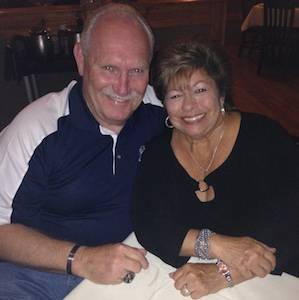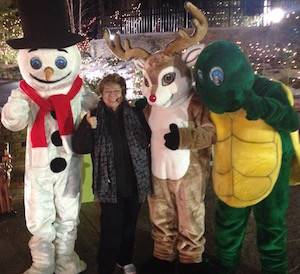
…And then the shallow water knocked her over. “I couldn’t get up because I was so disoriented with the vertigo,” says Linda. “People had to come in and help Gary get me up. Otherwise, I would have drowned.”
Sure, the incident in Aruba was dangerous. Linda found it embarrassing, to boot. But similar incidents had been happening for years, and unbeknownst to Linda, they were symptoms of an even more dangerous problem for her: a condition called Chiari malformation.
In Chiari malformation, part of the base of the brain is compressed downward into the spinal canal. Some Chiari malformations cause no symptoms. Others, like Linda’s, can cause dangerous complications. Ultimately, Dr. Gatean Moise of Neurosurgeons of New Jersey performed a surgery that corrected Linda’s Chiari malformation, allowing her to enjoy life once more.
But that day in Aruba, Linda hadn’t met Dr. Moise yet. She had never heard of Chiari malformation. She had been having symptoms for seven years, and nobody could tell her what was wrong.
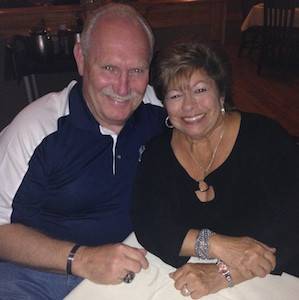
Her symptoms started with headaches that came on when she laughed or coughed. Gradually, the headaches got more frequent and more severe. After a few years, her doctor sent her to get an MRI. The MRI wasn’t conclusive. Then Linda started to get vertigo. She saw a neurologist. She tried medication. Nothing helped.
And her symptoms only got worse. “I felt like I was being paralyzed,” says Linda. “When I got up from a chair I couldn’t walk, because my legs just didn’t work. I’d have to wait a minute or so, but then they became so heavy they felt like they were five hundred pounds apiece.” And she was in pain. “I felt like all my extremities were plugged into sockets, like I was getting electric shocks. This was all day.”
She started going fewer and fewer places with her husband. She had trouble working a full day in her job as secretary to the town’s chief of police. And though she is normally fun-loving and irrepressible, Linda became less and less likely to laugh. She wanted to avoid bringing on her headaches and vertigo. “You know how difficult it is not to be able to laugh heartily when you like to laugh?” says Linda. “It’s just so hard.”
Eventually her doctor recommended Neurosurgeons of New Jersey. There she met with Dr. Alfred Ogden. “He’s the one that diagnosed me,” says Linda. “He looked at my MRI, and within a minute or so he knew exactly what was wrong. For seven years I had been trying to find out.” Linda was incredibly relieved.
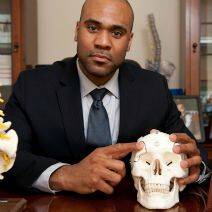
Linda’s surgeon, Dr. Gatean Moise
Surgery to correct Chiari malformation is not one of Dr. Ogden’s particular specialties. So he recommended that Linda see one of his associates. That’s how she ended up in the capable hands of Dr. Gatean Moise. Linda is grateful for the chain of events.
“It was meant to be,” she says. “I could tell as soon as my husband and I met Dr. Moise, from the minute I saw the man and his beautiful smile. He told us to sit down and he said, ‘Tell me what’s going on.’ I said, ‘Do you have an hour?’ He says, ‘I have as long as you need, and you can ask me anything.’”
Dr. Moise listened to Linda’s story and answered her questions. Then he explained to Linda and her husband the surgery she would need. “I was very comfortable,” says Linda.
She recalls the day of the surgery: “We went to the hospital—Valley Hospital is an excellent facility. It’s spotless. The staff was wonderful. The nurses prepping me for surgery and the ones in the surgical room, they were just phenomenal. I did start to get a little bit nervous towards the end [of the surgical prep], and I said to the one nurse, “Would you hold my hand?” She said, “Yes.” So she held my hand. I said, “Will you pray for me?” She said, “Definitely, I’ll pray for you.”
The surgery took about three hours, just as Dr. Moise had predicted. And when Linda woke up, the difference was immediate. “I was coming to, I was still halfway out of it, and I didn’t have that tingling and sharp pain any more in my arms, in my hands, in my legs. I didn’t have any of it. I just took my hands and I threw them up and I said to my husband, ‘Hon. Look! Look! Look! I’m all better now! Look!’ The nurse said, ‘Okay, Mrs. Edwards. Calm down.’”
When Dr. Moise came in to check on her, Linda gave him a hug. “You just gave me my life back,” she said.
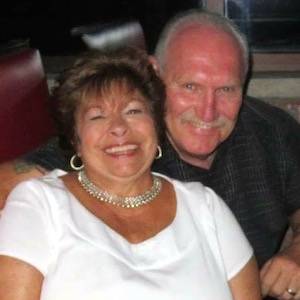
Linda and Gary share a laugh
Linda recuperated in the hospital for three days, and then she returned home. Two weeks later, she took her first walk down the block with Gary. He helped her just down to the street corner. Out and about with her husband and pain-free, she was overwhelmed with joy. “We’re outside on the street corner. I said, ‘Come on, let’s dance.’ He said, ‘What are you, crazy?’ I said, ‘No. I just feel so good! I’m just so happy.’”
As her strength increased, Linda’s joy at living without symptoms remained strong.
Two weeks after their dance on the street corner, Linda’s husband went out to an actual dance, an event that Linda herself didn’t feel ready for. When Gary came home, he entertained her with the stories of everything that happened at the dance. She remembers laughing, and then “laughing so hard, and then I started crying. He said, ‘Why are you crying?’ and I said, ‘Because I can laugh again!’ “
Before her surgery, Linda had become sedentary. Now that she was free of symptoms, she worked to build up her stamina. First she walked a block on her own. Then three blocks. Then a lap around the park. Now she averages three-mile walks. In the last year, she has lost thirty-five pounds.
Linda is back to work full time. And she is full of thanks for Dr. Moise. “I’m so grateful to Dr. Moise for having the knowledge and the skill,” she says. “He is a brilliant, brilliant surgeon with the best bedside manner there is. He was just phenomenal.” She has plenty of praise for the rest of his staff, too–assistants, schedulers, everyone. “I had a wonderful experience,” she says.
Linda and Gary are back to enjoying their fourth decade of marriage, full of adventure and laughter once more. “I’m not afraid to go anywhere or do anything now,” she says. “Gary will say, ‘What do you want to do this for?’ and I’ll say, ‘Because I can!’ That’s what I say now. Because I can.”
Learn more about Dr. Moise on his bio page here.
Learn more about Dr. Ogden on his bio page here.
Image credit, Eagle Beach Aruba: [Rumblebee] / Wikimedia Commons


